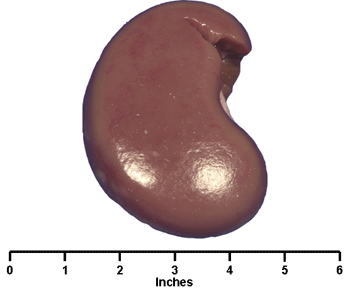Sheep Discovery: Retail Cuts
Sheep Discovery: Retail Cuts
Cuts Taken from the Shoulder
- Thick roast that is more than 2 inches thick.
- Contains arm, blade, and rib bones.
- Has a variety of muscles.
- Has fat and connective tissue seperating the muscles, and fat covering the outside of the cut.
*Cookery Method = Dry or Moist
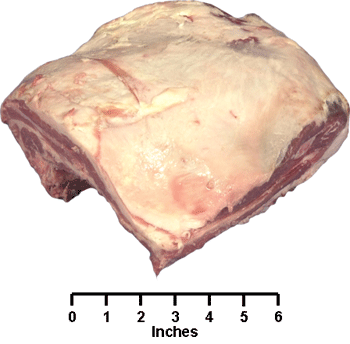
- Cross section of the neck portion of the shoulder that is cut less than 2 inches thick.
- Contains vertebrae and the spinal cord is visible.
- Has many different symmetrical muscles visible on the cut sides.
- Has some fat and a large amount of connective tissue.
*Cookery Method = Moist
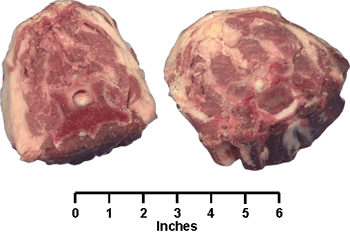
- Cut form the upper part of the shoulder that is cut less than 2 inches thick.
- Contains blade bone (sometimes in the shape of "7"), vertebrae, and rib bones.
- Has several different muscles visible.
- Has some fat and connective tissue separating the muscles, as well as some fat on the outside edges.
*Cookery Method = Dry or Moist
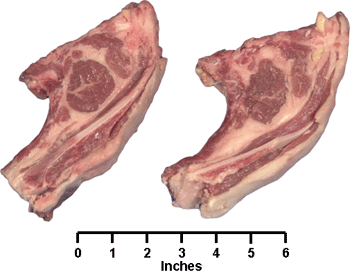
Cuts Taken from the Breast
- Large cut taken from the breast.
- Contains breast bone and rib bones.
- Has several different thin, flat muscle visible.
- Has some fat and connective tissue separating the muscles, as well as some fat on the outside edges.
*Cookery Method = Dry or Moist
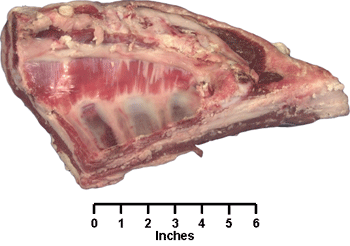
- Long, narrow cuts taken form the breast.
- Contains rib bones.
- Has several different thin, flat muscles visible.
- Has a good bit of fat separating the muscles.
*Cookery Method = Dry or Moist
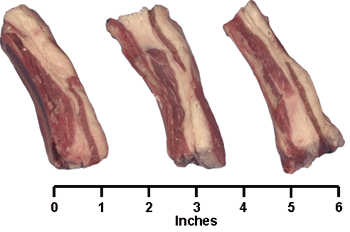
Cuts Taken from the Shank
- Large cut taken from below the shoulder.
- Contains leg bone and part of the round arm bone.
- Has many different muscles visible on cut sides.
- Has lots of fat and connective tissue separating the muscles, as well as considerable amounts of fat on the outside edges.
*Cookery Method = Moist
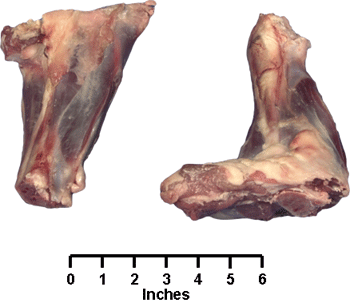
Cuts Taken from the Rack
- Large cut that includes part of rib cage.
- Contains rib bone and vertebrae.
- Large end has one main muscle (ribeye) surrounded by several smaller muscles visible, and small end has only the ribeye muscle visible.
- Has some fat and connective tissue separating the muscles, and some outside fat opposite the ribs.
*Cookery Method = Dry
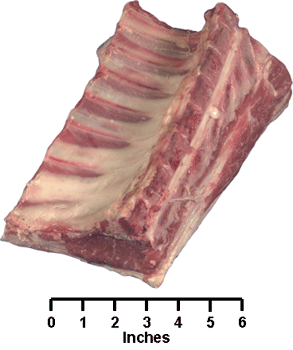
- Large cut that is similar to the Lamb Rack Rib Roast, except bones have been removed.
- Contains no bone.
- Contains the ribeye muscle and several smaller muscles. Usually tied together.
- Has some fat and connective tissue separating the muscles, and some fat on the outside.
*Cookery Method = Dry
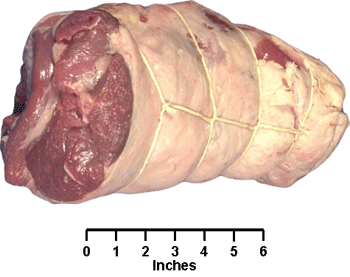
- Chops cut from the rib cage the thickness of one rib bone (usually 3/4 to 1 inch thick).
- Contains rib bone and vertebrae.
- The largest muscle is the ribeye which may be surrounded by smaller muscles.
- Has some fat and connective tissue separating the muscles, and some outside fat opposite the rib bone.
*Cookery Method = Dry
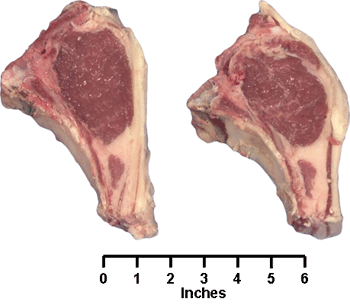
Cuts Taken from the Loin
- Large roast that is taken past the last rib.
- Contains vertebrae ("T" shaped bone) and may have one rib bone on the rib end.
- The rib end has one main muscle (top loin), and the loin end has the top loin and the smaller tenderloin muscles. Smaller muscles also present.
- Has some fat and a little connective tissue separating the muscles, and some outside fat opposite the ribs.
*Cookery Method = Dry
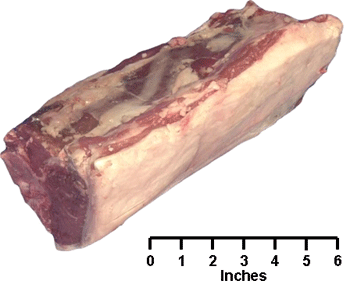
- Chops cut from the Lamb Loin Roast (usually 1 to 1 1/2 inches thick).
- Contains vertebrae ("T" shaped bone.
- The largest muscle is the top loin, and the smaller muscle is the tenderloin.
- Has some fat and connective tissue separating the muscles, and some fat on the outside edge.
*Cookery Method = Dry
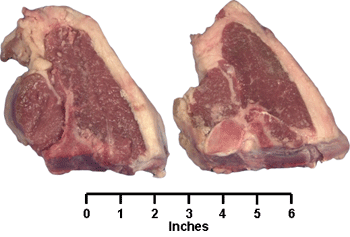
- Chops which are a cross-section of an unsplit loin (usually 1 to 1 1/2 inches thick).
- Contains vertebrae ("T" shaped bone).
- The largest muscle on each side is the top loin, and the smaller muscle on each side is the tenderloin.
- Has some fat and connective tissue separating the muscles, and some fat on the outside edge.
*Cookery Method = Dry
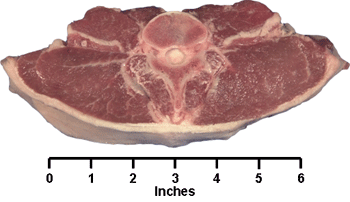
Cuts Taken from the Leg
- Large cut taken from the upper area (sirloin half) of the Leg.
- Contains hip bone and part of the round leg bone.
- Contains several large muscles.
- Has fat and connective tissue separating the muscles, and fat on the outside edges.
*Cookery Method = Dry
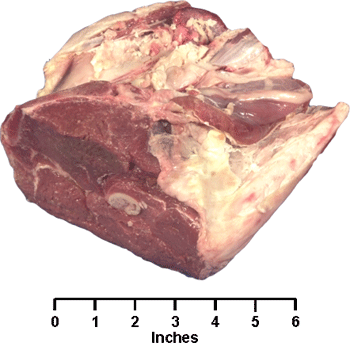
- Large cut taken from the lower area (sirloin half removed) of the Leg.
- Contains round leg bone.
- Contains several large muscles visible in the exposed cut area.
- Has fat and connective tissue separating the muscles, and fat on the outside edges.
*Cookery Method = Dry
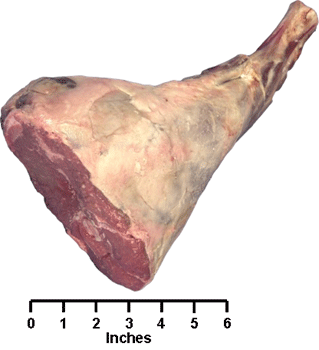
- Large cut taken from the lower area of the Leg. Tapers in size form the sirloin end.
- contains round leg bone visible in the sirloin end, and at least 1 inch of leg bone that has been "Frenched" or exposed in the shank end.
- Contains several large muscles ivsible in the exposed sirloin.
- Has fat and connective tissue separating the muscles, and fat on the outside edges.
*Cookery Method = Dry
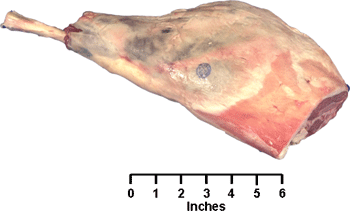
- Large cut taken from the lower area of the Leg.
- Contains round leg bone visible in the sirloin end. Leg bone has been removed fomr the tapering leg end and the meat folded over.
- Contains several large muscles visible in the exposed cut area.
- Has fat and connective tissue separating the muscles, and fat on the outside edges.
*Cookery Method = Dry
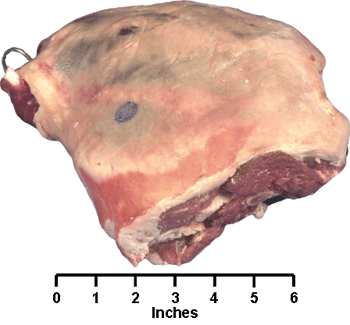
- Chops taken from the sirloin section of the Leg (usually cut less than 1 inch thick).
- Contains backbone and part of the hip bone (round or flat shaped).
- Contains several muscles of varying size.
- Has some fat and connective tissue separating the muscles, and some fat on the outside edge.
*Cookery Method = Dry
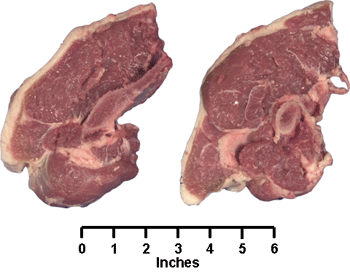
- Cut taken from the center part of the Leg (usually cut less than 1 inch thick).
- Contains a round leg bone.
- Contains the top, bottom, eye, and tip muscles.
- Has some fat and connective tissue separating the muscles, and some fat on the outside edge.
*Cookery Method = Dry
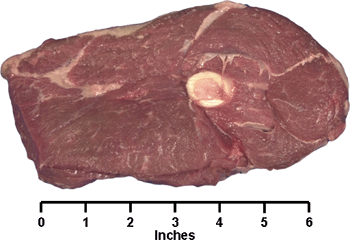
Sheep Variety Meat Cuts
- Similar in shape to beef and port heart, but smaller in size.
- It is generally sold either cut or split.
*Cookery Method = Dry or Moist
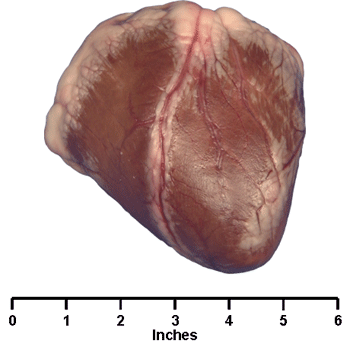
- Has two lobes, with one being predominantly larger than the other.
- Smaller in size to that from beef or pork.
*Cookery Method = Dry or Moist
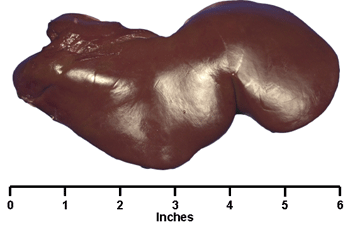
- Shaped like a kidney bean.
- Smaller in size the that from beef or pork.
*Cookery Method = Dry or Moist
